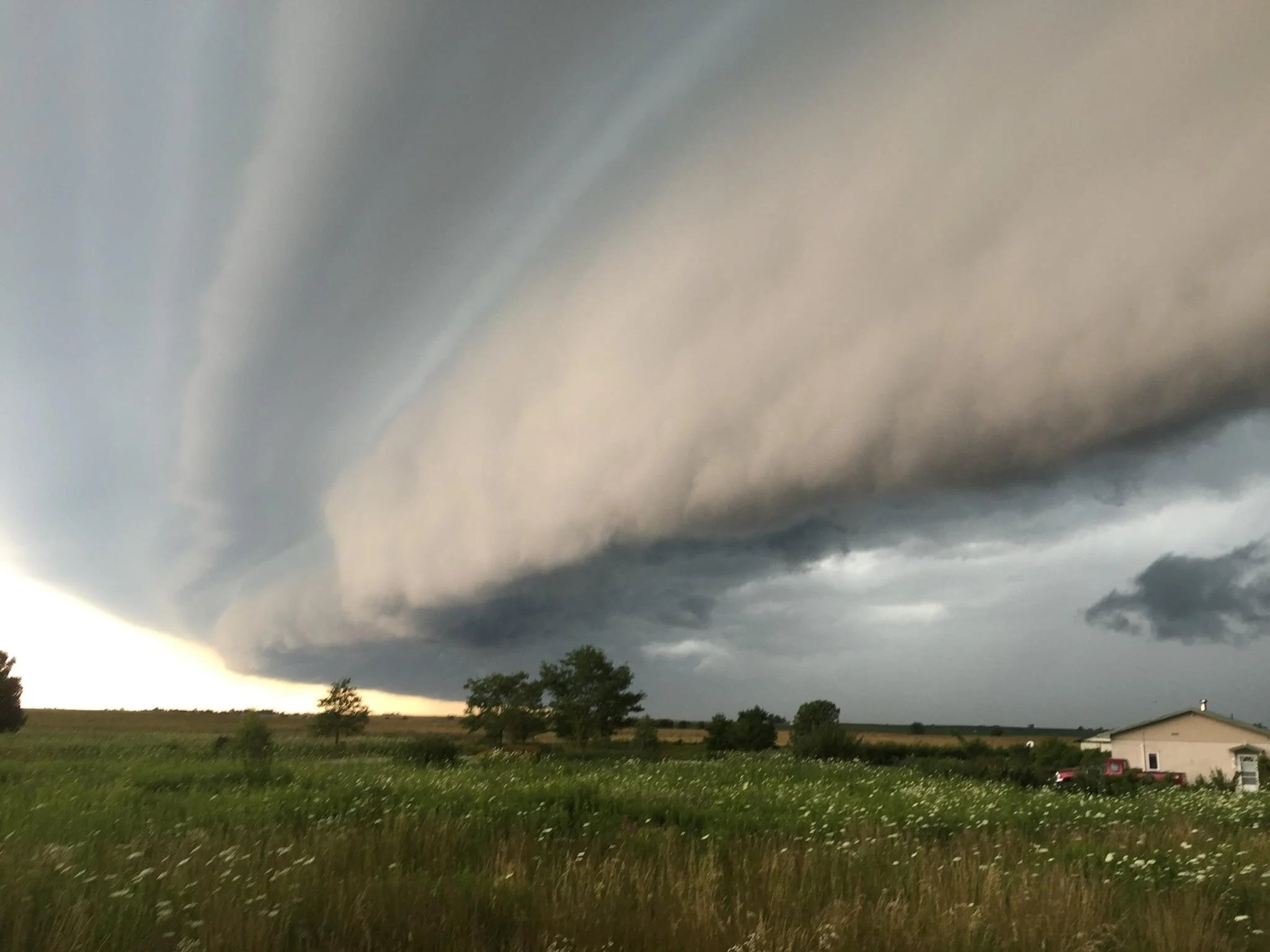Tornadoes…!!!???
They have never touched down in Stelle but they have been close by.
We get some of the most wonderful cloud formations and storms here on the prairie with thunder and lightening that will shake the windows at times. They are a humbling reminder of just how small we are. But there is rarely any damage to property and so far, never any people. Now that the trees in Stelle have grown to be a good size we have begun to do more limb clean-up in recent years.
Safe Places in Stelle
The safest place to be during a tornado is in a basement. There are not many of those in Stelle (because of the high water-tables here in the spring) but here is a map of residents with basements that will welcome you with open arms. Just run over, knock on the door and get inside. When there becomes a chance of tornadoes you might hear the emergency warning sirens sounding from nearby communities like Kempton and Cabery.
Here is a little more information we’ve gathered on tornadoes.
Spawned from powerful thunderstorms, tornadoes can cause fatalities and devastate a neighborhood in seconds. A tornado appears as a rotating, funnel-shaped cloud that extends from a thunderstorm to the ground with whirling winds that can reach 300 miles per hour. Damage paths can be in excess of one mile wide and 50 miles long.
Some tornadoes are clearly visible, while rain or nearby low-hanging clouds obscure others. Occasionally, tornadoes develop so rapidly that little, if any, advance warning is possible.
Before a tornado hits, the wind may die down and the air may become very still. A cloud of debris can mark the location of a tornado, even if a funnel is not visible. Tornadoes generally occur near the trailing edge of a thunderstorm. It is not uncommon to see clear, sunlit skies behind a tornado.
The following are facts about tornadoes:
· They may strike quickly with little or no warning.
· They may appear nearly transparent, until dust and debris are picked up or a cloud forms in the funnel.
· The average tornado moves southwest to northeast, but tornadoes have been known to move in any direction.
· The average forward speed of a tornado is 30 MPH, but may vary from stationary to 70 MPH.
· Peak tornado season in the northern states is spring through early summer.
· Tornadoes are most likely to occur between 3 p.m. and 9 p.m., but can occur at any time.
What to do Before and During a Tornado
Assemble a Disaster-Supplies Kit
Kit should include 1) First-aid kit and essential medications 2) High-energy food, canned food, and can opener; 3) At least three gallons of water per person; 4) Protective clothing, bedding or sleeping bags; 5) Battery-powered radio, flashlight, and extra batteries; 6) Special items for infant, elderly, or disabled family members; 7) Written instructions on how to turn off electricity, propane, and water if necessary. See the complete, detailed list attached.
Be alert to changing weather conditions.
Listen to a NOAA Weather Radio or to commercial radio or television newscasts for the latest information. Know the difference between a tornado WATCH (a tornado is possible in your area) and a tornado WARNING (a tornado has been sighted and may be headed for your area).
· Look for approaching storms
· Look for the following danger signs:
· Dark, often greenish sky
· Large hail
· A large, dark, low-lying cloud (particularly if rotating)
· Loud roar, similar to a freight train.
If you see approaching storms or any of the danger signs, be prepared to take shelter immediately. Head to one of the ‘Safe Basements’ in Stelle if you wish to take extra precautions. Instruct your children to return home immediately if a storm is approaching or to take shelter at the nearest home available. A room in your home should be selected in a basement or an interior room on the lowest level away from corners, windows, doors, and outside walls. An interior bathroom with no windows, a center hallway, or a closet are options if no basement is available. Put as many walls as possible between you and the outside. Do not open windows. Take cover under a heavy object, such as a sturdy workbench or table, and use your arms to protect your head and neck. You might also want to store heavy blankets and bicycle helmets in your safe room to give yourself added protection during a storm. If possible, take your cordless phone or cell phone with you to your safe room. Keep a whistle in your safe room to alert rescuers of your location if necessary.
If you are in a vehicle, trailer or mobile home: Get out immediately and go to the lowest floor of a sturdy, nearby building or a storm shelter. If there is no shelter available, lie flat in a nearby ditch or depression and cover your head with your arms and hands. Be aware of the potential for flooding. Do NOT get under an overpass or bridge, which will act as a funnel for wind and debris. You are safer in a low, flat location. Watch out for flying debris. Flying debris from tornadoes causes most fatalities and injuries. Watch out for fallen power lines. Never drive over a downed electrical line.
What to do After a Tornado
Check for injuries. Do not attempt to move seriously injured persons unless they are in immediate danger of death or further injury. If you must move an injured or unconscious person, first stabilize the neck and back then call for help immediately.
Listen to the radio for information and instructions.
Use a flashlight to inspect your home for damage. Do not use candles at any time. Note: The flashlight should be turned on outside before entering. The battery may produce a spark that could ignite leaking gas, if present. Do not enter your home if you smell gas/propane. Turn off propane at the tank if possible to do safely.
Sparks, broken, or frayed wires. Check the electrical system unless you are wet, standing in water, or unsure of your safety. If possible, turn off the electricity at the main fuse box or circuit breaker. If the situation is unsafe, leave the building and call for help. Do not turn on the lights until you are sure they are safe to use. You may want to have an electrician inspect your wiring.
Roof, foundation, and chimney cracks. If it looks like the building may collapse, leave immediately.
Appliances. If appliances are wet, turn off the electricity at the main fuse box or circuit breaker. Then, unplug appliances and let them dry out. Have appliances checked by a professional before using them again. Also, have the electrical system checked by an electrician before turning the power back on.
Water and sewage systems. If pipes are damaged, turn off the main water valve. Check with local authorities before using any water since the water could be contaminated. Do not flush toilets until you know that sewage lines are intact.
Food and other supplies. Throw out all food and other supplies that you suspect may have become contaminated or come into contact with flood water. If your basement has flooded, pump it out gradually (about one third of the water per day) to avoid damage. The walls may collapse and the floor may buckle if the basement is pumped out while the surrounding ground is still waterlogged.
Opening cabinets. Be alert for objects that may fall when cabinets are opened.
Clean up household chemical spills. Use a bleach solution to disinfect items that may have been contaminated by raw sewage or bacteria.
Call your insurance agent. Take pictures of damages. Keep good records of repair and cleaning costs. Before disaster strikes, it is a good idea to create an inventory list (with pictures) of household items and their value to present to the insurance company. Keep this, as well as other important documents, in a safe place, such as a bank lock box.


